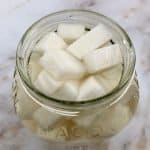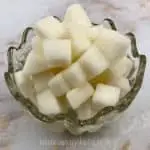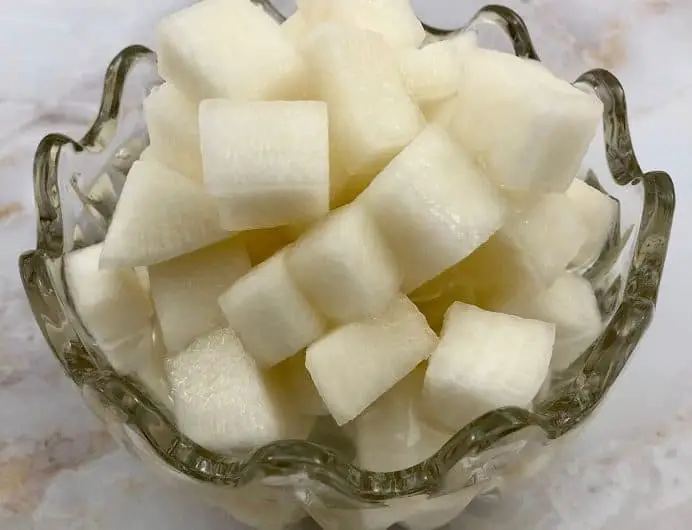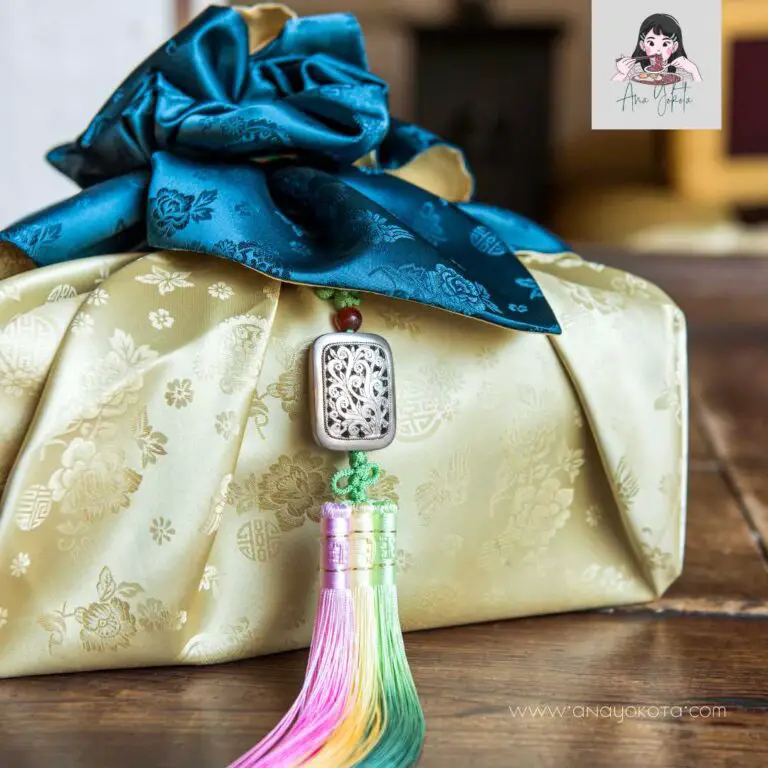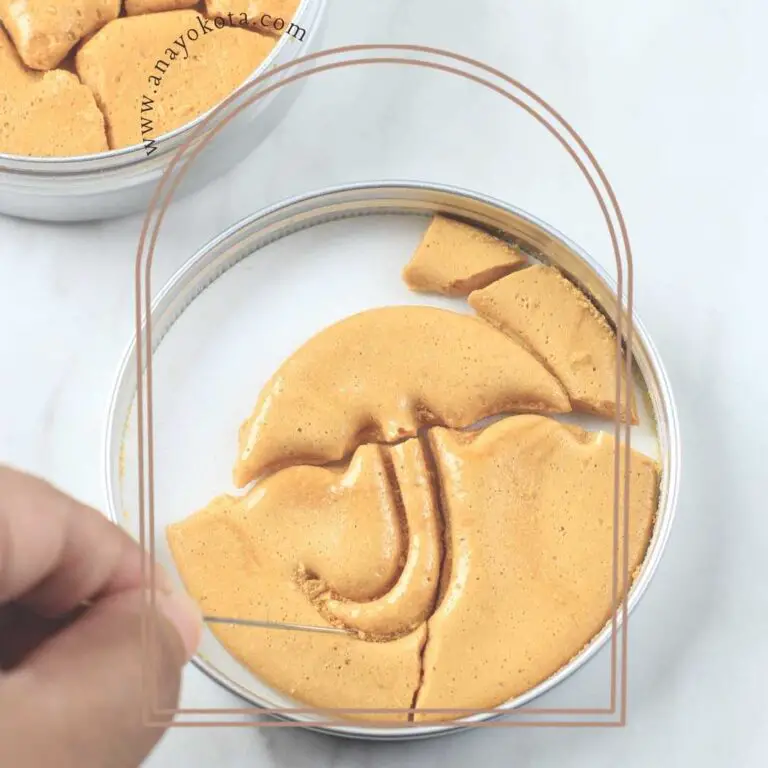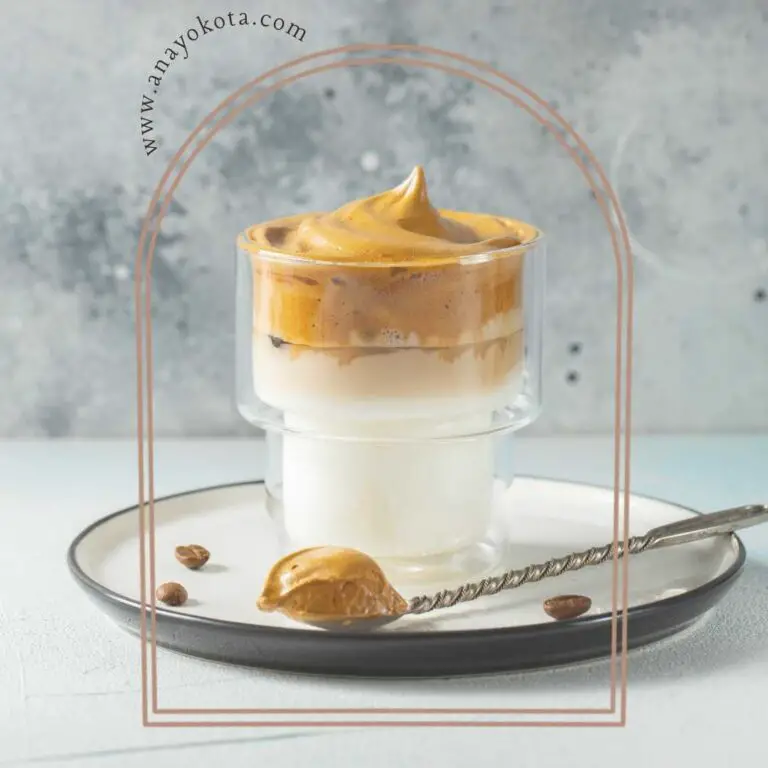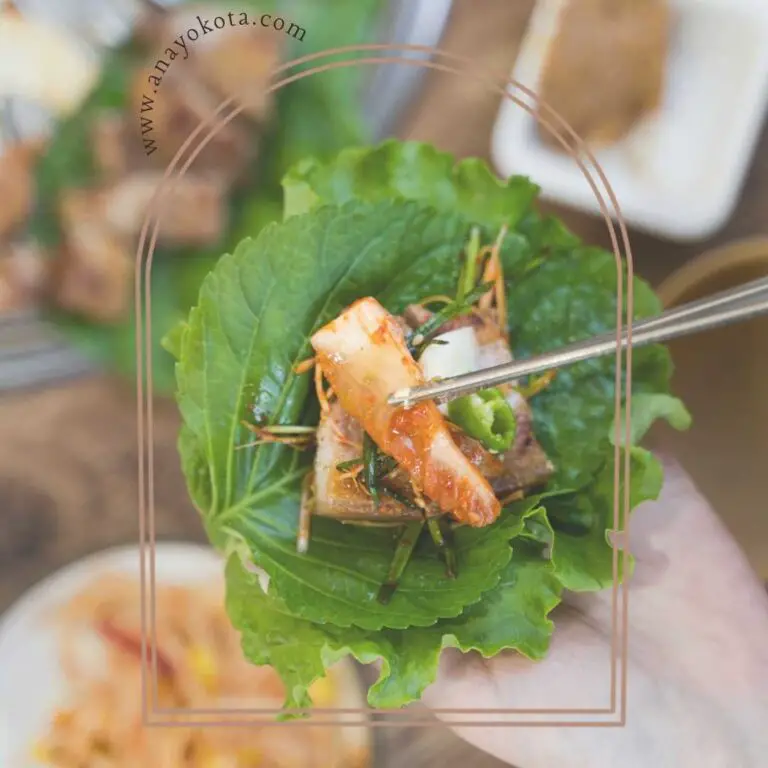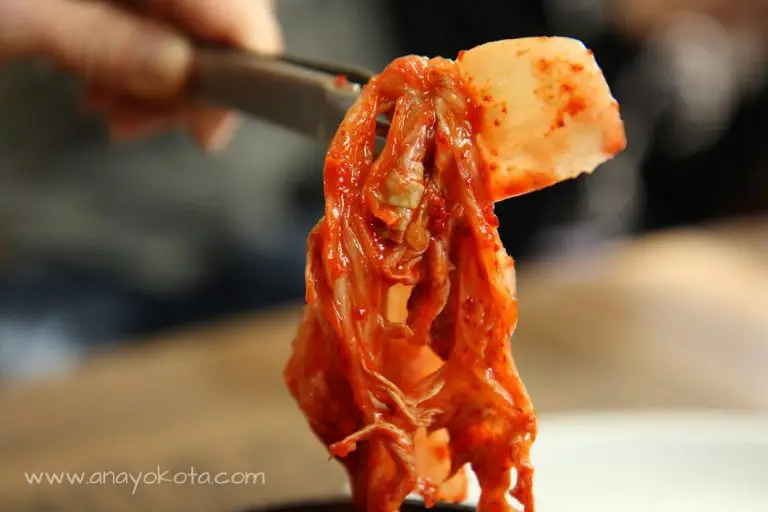This post may contain affiliate links. Please read my disclosure policy for more info.
Pickled Korean radish is the perfect combination of sweet, salty, tangy, and crunchy all in one bite. It’s a perfect pairing for the iconic Korean style fried chicken! Despite its addictive flavors, it’s so easy to make, I’m a little embarrassed.
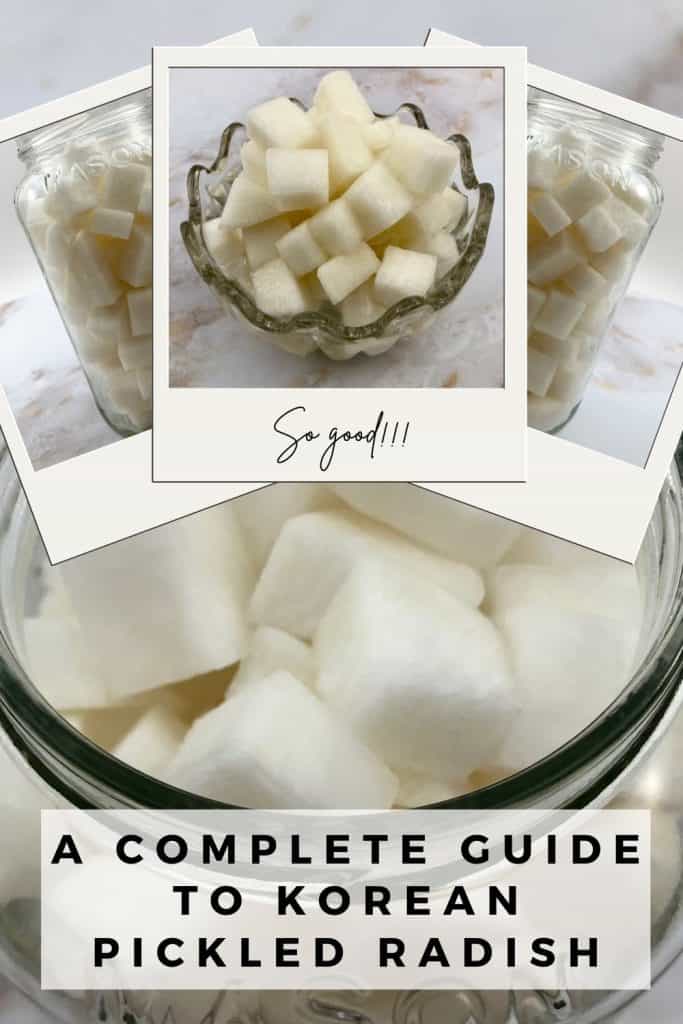
One day a friend of mine who was interested in Korean food asked me, “In Korean fried chicken what is the white square crunchy food they eat on the side?” To which I enthusiastically answered, “chicken mu!” I explained that chicken mu is Korean for Korean radish pickle.
Pickled Korean radish is a popular banchan (sidedish) with many Korean foods other than fried chicken such as, bulgogi chicken, bulgogi pork, cold noodles (naengmyeon), kimchi fried rice (kimchi bokkeumbap), pizza, and pretty much anything that is on the heavier (or greasier) side.
It’s also a wonderful way to introduce daikon as a Korean side dish to those that may not know all the variations of Korean daikon banchan such as chonggak kimchi (little daikon radish kimchi), musaengchae (julienned daikon kimchi), and danmuji (pickled yellow daikon).
I would always buy pickled Korean radish when my family would eat Korean fried chicken. But, when I realized how incredibly easy and cheap this chicken mu (mu is daikon in Korean) was, I vowed to start making my own. Furthermore, making your own Korean pickled radishes enables you to control the intensity of each ingredient. For example, if you wanted it to be less sweet, simply add less sugar. If you want it to be less salty, add less salt. Etc…
You can make this Korean pickled radish recipe in minutes and have it ready in just a couple of hours. To learn more about pickled Korean radish as well as how to make this fast and easy recipe, keep on reading!
WHAT IS PICKLED KOREAN RADISH
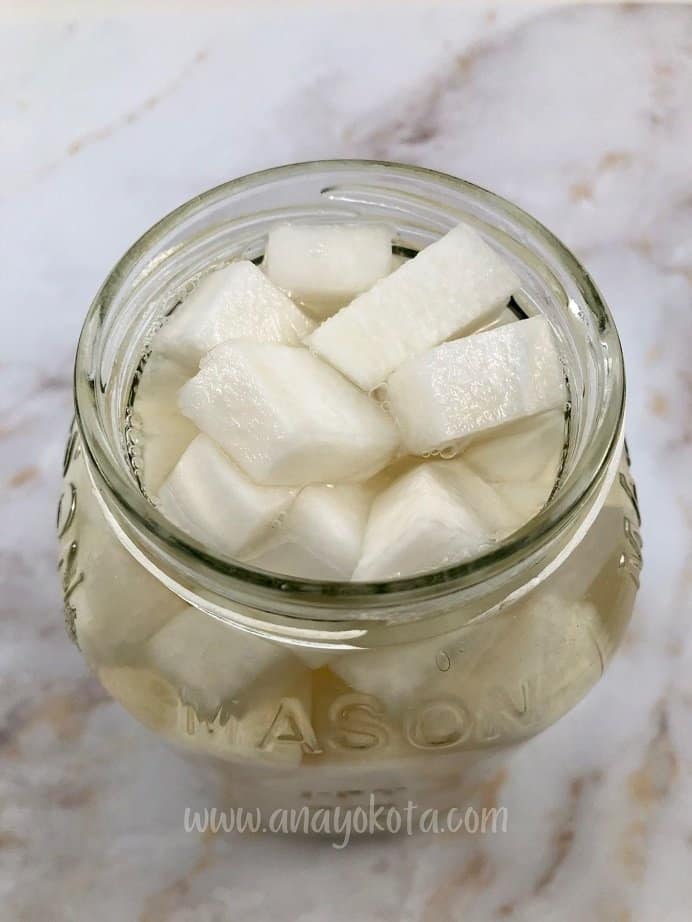
Pickled Korean radish is made with white daikon radish (or Japanese radish) that has been pickled in a vinegar brine mixture. The brine is typically composed of vinegar, sugar, salt, and water.
What Is Korean Pickled Radish Called?
Korean pickled radish is called 치킨 무 (chicken mu). 치킨 (chicken) is the phonetic translation of the word chicken. 무 (mu) is Korean for daikon. So, put the two words together and you get chicken mu. The reason why it is called chicken mu is because this Korean pickled daikon recipe is always paired with Korean fried chicken.
Is Korean Pickled Radish Healthy?
Disclaimer: Based on my own research and opinions (I am not a health expert, so please do your due diligence and consult with your health expert when deciding if anything is healthy for you or not.)
As a cruciferous vegetable, radish is packed with vitamins and minerals that are associated with compounds that help fight certain cancers and heart diseases (SOURCE). It truly is a powerhouse vegetable as It is also low in calories and carries incredible nutrition that is very healthy for you such as folate, vitamin C, fiber, and potassium (SOURCE). You can use every part of the daikon including its earthy leafy parts that are great in soups, salads, and (of course) pickled.
Pickling this powerhouse vegetable is healthy because of the probiotics. Probiotics are properties that help with digestion making it a great pairing for greasy or heavy foods like Korean fried chicken (SOURCE).
Can I Eat Korean Pickled Radish While Pregnant?
Disclaimer: Based on my own research and opinions (I am not a health expert, so please do your due diligence and consult with your health expert when deciding if anything is healthy for you or not.)
I believe that pickled Korean radish is good for you because it has wonderful nutrients for good baby growth. For example, you can eat Korean pickled radish while pregnant as it has probiotics known to help with gut health (SOURCE).
So why do some say that Korean daikon pickle is bad for you?
Well, the biggest reason why I avoided pickled Korean radish during my pregnancy is when it was sold in stores or restaurants because I did not know how it was prepared; specifically, how it was washed. Not thoroughly washing your fruits and vegetables while you are pregnant is not the safest because it can have harmful bacteria that the baby’s immune system cannot fight and therefore can harm the baby. So rather than thinking that picked radish is bad for you, think about if it was washed properly.
So, how do you wash radish properly? My mother has taught me to wash all my vegetables with hard skin in a vinegar bath for at least 30 minutes. A small spoonful of vinegar in filtered water is all you need to ensure a clean wash.
How Long Does Korean Pickled Radish Last?
Korean pickled radish can last for a few weeks when stored properly in an airtight container in the refrigerator. I have stored Korean daikon in a specialized kimchi fridge for a couple of months and it still tasted fresh and delicious. So long as the radish has been pickled properly, it should be safe to eat within a few weeks.
What Does Korean Pickled Radish Taste Like?
Korean pickled radish tastes like a juicy, sweet, mild dill pickle. In other words, it is sweet, salty, and vinegary. The texture is crunchy like a crisp apple or asian pear.
Why Is Korean Pickled Radish Yellow?
Korean pickled radish that is yellow is called danmuji or dakwang (in Japanese). Unlike the chicken mu (pickled Korean radish eaten with fried chicken), danmuji is usually seen with Korean style Chinese food such as Jjajangmyeun or Jjampong. Danmuji is yellow for cultural reasons and most commercially sold danmuji uses food coloring. To learn more about pickled yellow daikon and learn how to make it without artificial food coloring, check out my article!
Can You Freeze Korean Pickled Radish?
I highly recommend that you do not freeze Korean pickled radish because it will lose texture and flavor. After testing it myself, I found that the daikon had a limp-y texture and lacked the same fresh flavor.
What To Eat With Korean Pickled Radish?
The most common pairing with Korean pickled radish is Korean fried chicken. Hence the popular name, chicken mu. However, as mentioned above, you can pair Korean pickled radish slices or squares with triangle kimbap, pizza, noodles, fried rice and even yubuchobap! Since pickled radish is such a neutral flavor, I believe it goes well with pretty much any Korean inspired dish.
What Is A Good Substitute For Daikon Radish?
A good substitute for daikon radish is kimchi. My absolute favorite Korean banchan is Kimchi as it is symbolic to Korean cuisine. Another alternative to daikon radish is pickled cabbage, which is essentially made the same way but using cabbage instead.
Where To Buy Korean Pickled Radish?
If you are looking for premade Korean pickled radish, the best place to purchase it is at your local Korean grocery store such as HMart, Zion, or Arirang if you are from the states. However, if you do not have access to these brick and mortar stores, I have seen them sold online such as Weee!.
HOW TO MAKE PICKLED RADISH KOREAN STYLE
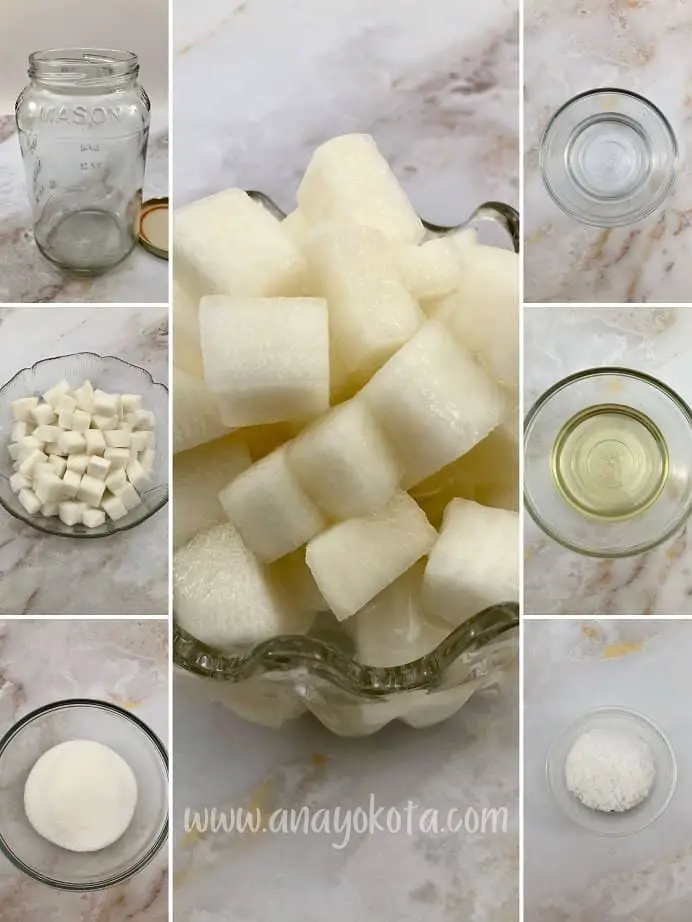
The key to good pickling is sanitizing your jar, cleaning the daikon properly, and investing in good quality fresh daikon.
How To Cut Korean Pickled Radish?
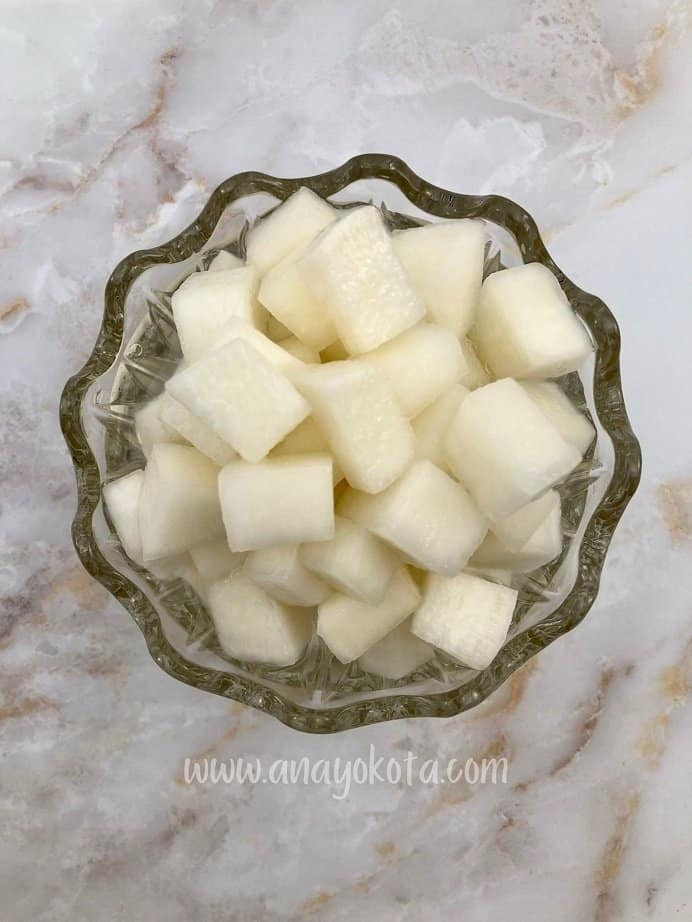
When it comes to cutting your radish, I am a fan of cutting them in cute little squares as this was how I was first introduced to Korean pickled radish. It is not only fun to eat but I feel that it has the best crunch compared to other cutting methods.
To cut into cute squares, thoroughly clean the daikon by soaking it in diluted vinegar water for 30 minutes. The reason why I choose to soak and clean the daikon even though I will peel the skin is because I use the skin to make dashi (soup base) for my soups and stews.
After you thoroughly clean the white daikon radish, slice them in ½ to ⅓ inch (about 2 cm) disks. Then stack them and cut the disks in ½ to ⅓ inch (2 cm) matchsticks. Line them up again and cut the other way about t½ to ⅓ inch (2 cm). This makes small ½ to ⅓ inch (2 cm) cubes perfect for chicken mu!
Pickled Korean Radish – Easy and Delicious
Cuisine: KoreanDifficulty: Easy8
5
minutes2
hoursLearn to make this sweet and tangy pickled Korean radish (daikon) that goes perfectly with Korean fried chicken! So easy, it takes less than 5 minutes to put it all together.
HOW TO PICKLED KOREAN RADISH INGREDIENTS
3 cups (370 g) – cubed which daikon radish (scroll up to learn how to cut into cubes)
¼ cup (60 ml) – rice vinegar
¼ cup (112 g) – white sugar
1 tsp (6 g) – salt (I prefer using iodized salt)
1 cup (2347 ml) – water
HOW TO PICKLE RADISH KOREAN STYLE INSTRUCTIONS
- In a sanitized glass container (eg: mason jar), put in all the cubed daikon and set aside.
- In a mixing bowl, put the rest of the ingredients together until the sugar and salt are dissolved.
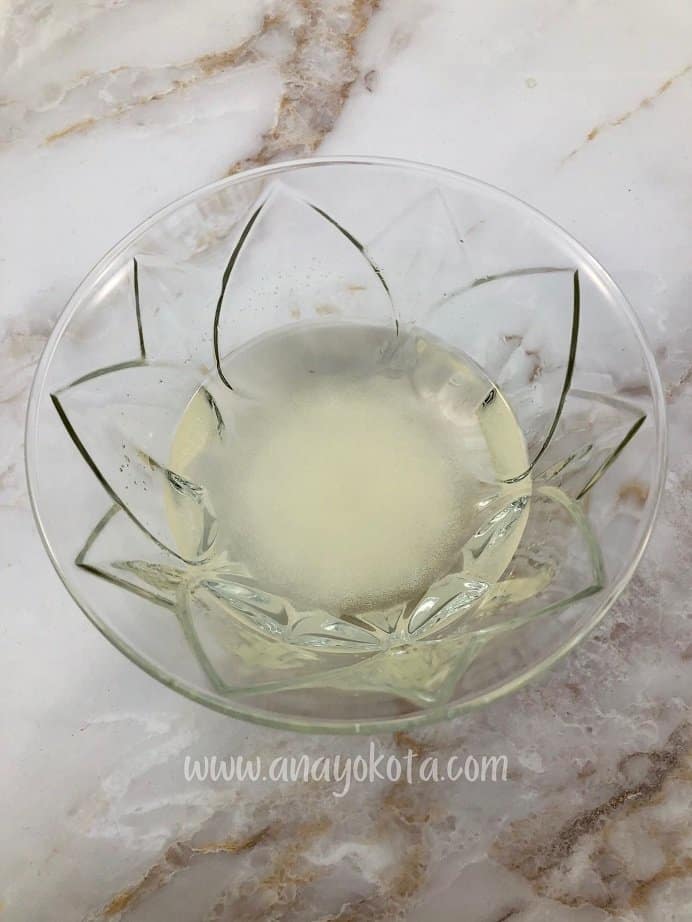
- Once everything has dissolved, gently pour the wet mixture over the daikon.
- Store at room temperature for 1-2 hours and then store it in the fridge for up to a few weeks. (If you have a specialized kimchi refrigerator, I have stored it for up to a couple months without it losing its crunchiness.)
- You can enjoy this after a couple hours; however, it is best when served chilled.
- Enjoy!
Notes
- After pickling, I would quickly rinse out the daikon right before serving. You don’t have to rinse out everything; just the amount you are serving. This will cut the saltiness and tanginess.
I hope you enjoyed this easy and fast pickled radish recipe. Once you master this recipe, you can always take it to the next level and add other aromatics or vegetables such as garlic, peppercorns, and carrots. Korean pickled radish and carrot is also a very popular mix. If you love pickled vegetables, please check out my article on pickled garlic or Korean yellow pickled radish. Yum!
So whether you use Korean pickled radish for kimbap or for fried chicken, I hope you give this recipe a try. Please tag me on social media (ajyokota) if you do! I’d love to see your creations!



